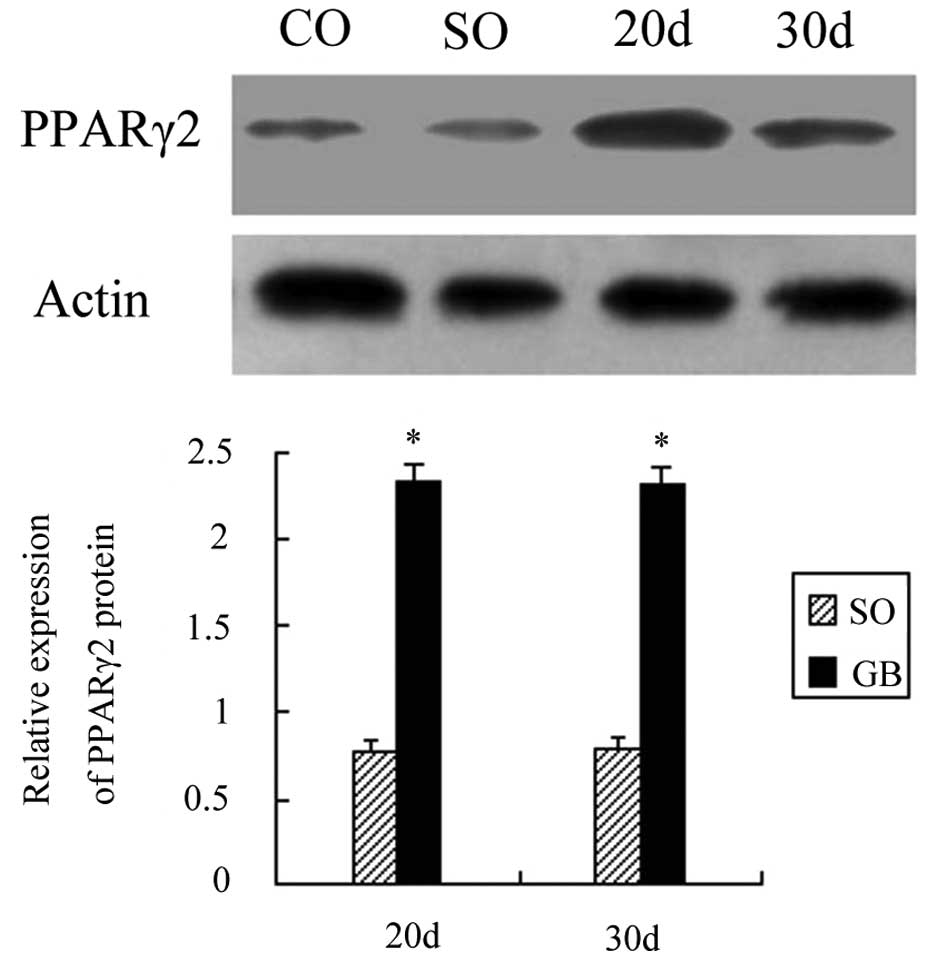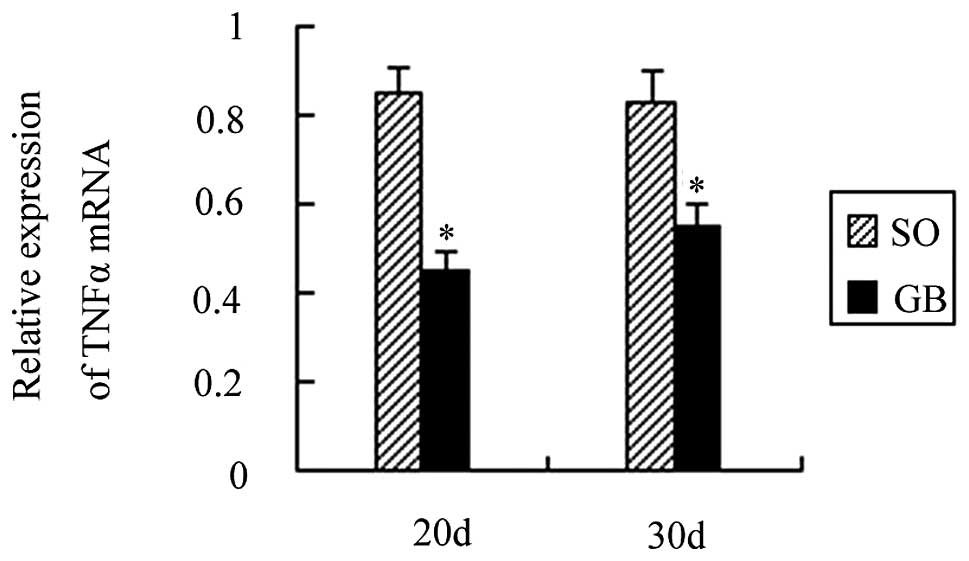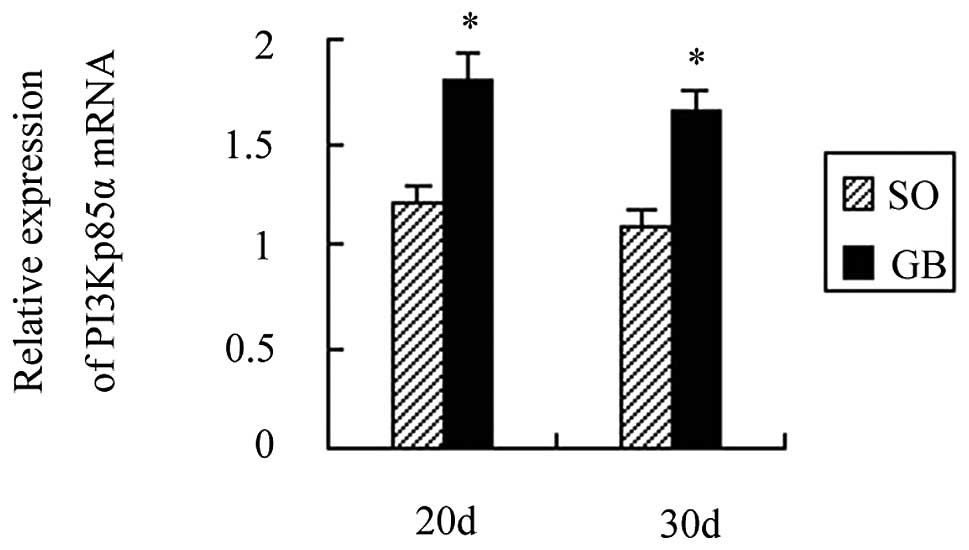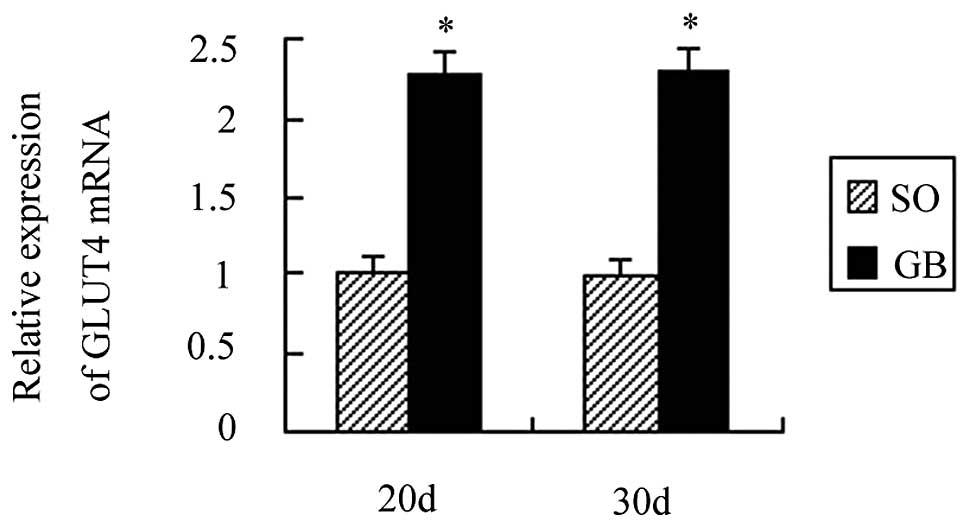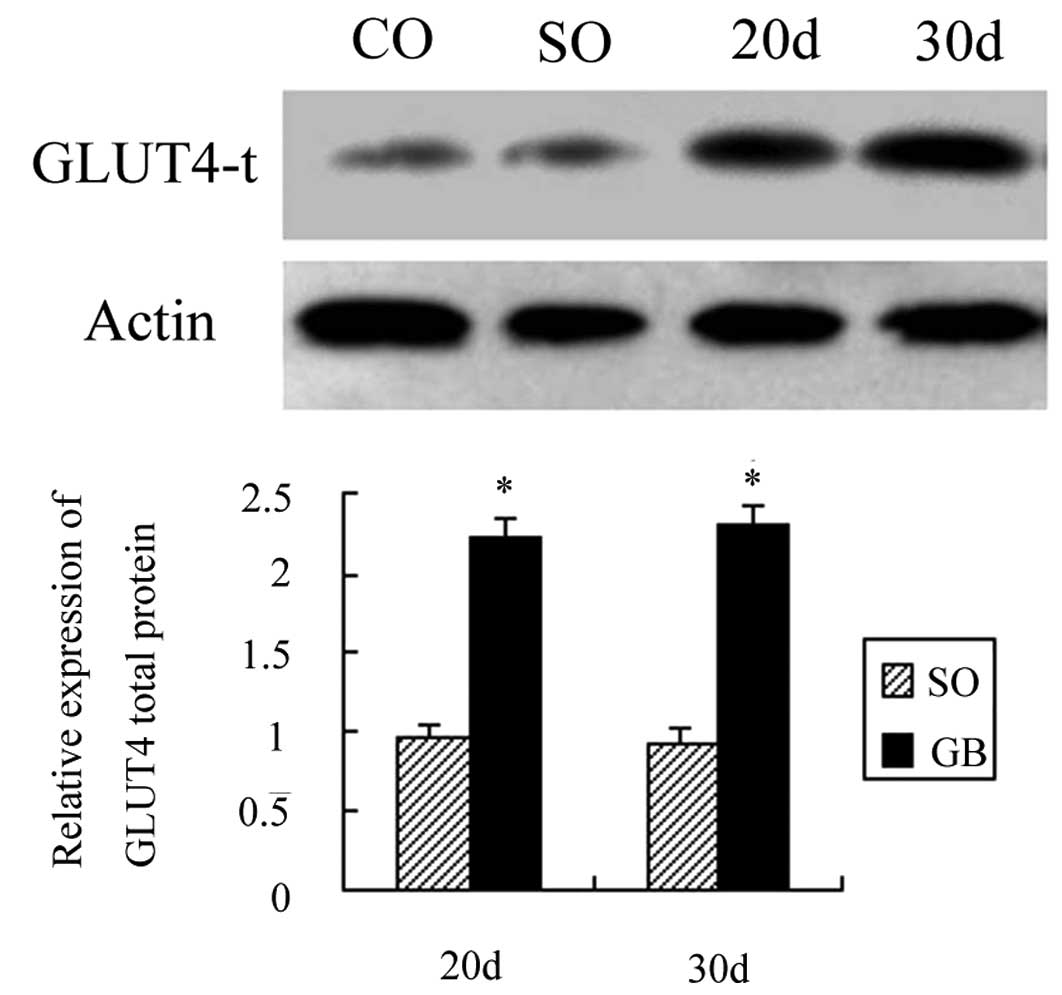Gastric bypass surgery alters the mechanisms of insulin resistance in the adipose tissue of GK rats
- Authors:
- Published online on: August 28, 2012 https://doi.org/10.3892/mmr.2012.1053
- Pages: 1111-1116
Abstract
Introduction
It has been reported that the incidence of diabetes has increased to up to 9.7% of the population over the age of 20 in China (almost 92.4 million in total) (1). Globally, China has become the country with the fastest growth in diabetes incidence, overtaking India. Type 2 diabetes mellitus (T2DM) patients account for 90% of all patients with diabetes, and the number of diabetes patients overall has increased primarily due to the increase in T2DM patients. Over the years, the clinical treatment of T2DM has involved using traditional conservative therapy, including drugs to stimulate insulin secretion and insulin replacement therapy. However, according to a recent study, drug therapy and insulin replacement therapy cannot delay the complications in high-risk T2DM patients and cannot improve the prognosis (2). A weight-loss surgeon discovered coincidentally that the blood glucose in obese Roux-en-Y gastric bypass (RYGB) patients with T2DM decreased to normal levels postoperatively and was maintained in the long-term (3). Currently, as the medical treatment of T2DM and control of complications is generally ineffective, this discovery will undoubtedly bring a glimmer of hope for the majority of T2DM patients.
The main clinical manifestations of T2DM include damaged islet cell function and progressive increases of insulin resistance (4). In the pathogenesis of T2DM, insulin resistance is an important link, which is mainly caused by decreasing the glucose uptake and use of the peripheral tissues. In the course of peripheral tissue glucose utilization, the transmembrane transport of glucose, which is mediated by glucose transporter 4 (GLUT4), is the main rate-limiting step.
Certain studies have shown that peroxisome proliferator-activated receptor γ2 (PPARγ2), tumor necrosis factor α (TNFα) and GLUT4 are closely related to insulin resistance (5–8). The expression of serum TNFα in patients with T2DM was upregulated significantly (9,10). Upregulation of GLUT4 may improve insulin resistance, while downregulation of GLUT4 expression may induce or exacerbate insulin resistance (11,12).
Currently, the mechanism of RYGB in the treatment of T2DM has become an international hotspot for research. However, its exact mechanism remains unclear. In this study, we supposed that RYGB may improve blood glucose through regulating certain fat factors and glucose transporter proteins. Therefore, investigating the changes in PPARγ2, TNFα, phosphatidylinositol-3-kinase subunit p85α (PI3Kp85α) and GLUT4 expression following RYGB surgery is essential in order to reveal the mechanism involved.
Materials and methods
Animal grouping
The experimental animals [8-week-old Goto-Kakizaki (GK) rats] were all purchased from SLAC, Ltd. (Shanghai, China). When the 60 male GK rats were adapted to the environment after two weeks, they were randomly divided into 6 groups (n=10). The surgery group 1 (GB1), sham operation group 1 (SO1) and control group 1 (CO1) were monitored 20 days after RYGB surgery, while GB2, SO2 and CO2 were monitored 30 days after RYGB surgery. The animals were housed in a SPF animal experiment center in Shengjing Hospital of China Medical University, and the feeding conditions were as follows: a normal day-and-night cycle, temperature 25±1°C, relative humidity 45±2%, with free access to water. The animal studies were agreed with the China Medical University Animal Research Committee.
Modeling
The GK rats underwent a 12-h fast and 4-h water deprivation prior to surgery and then were anesthetized with 10% chloral hydrate (3 ml/100 g intraperitoneal injection). We performed a 2.5-cm long incision in the middle upper abdomen. Gastric bypass surgery was performed in the surgery groups, in which approximately 10% of the stomach was kept at the end and the rest was removed, then the far end was closed. The jejunum was cut off 10 cm from the Treitz ligaments, and the distal intestinal loop lined residual gastrojejunostomy. End-to-side anastomosis was performed 10 cm away from the anastomosis at the proximal bowel and jejunum. In the sham groups, the cutting and in-situ anastomosis was performed using the equivalent anesthesia method and position, with the gastrointestinal tract anatomy unchanged. A similar surgical procedure was performed to ensure the same length of time, and consistency with 0/7 thread. The abdominal cavity was flushed by a 3 ml solution with 800,000 units penicillin. Free access to water was provided after the rats regained consciousness from anesthesia and free food after 24 h. Free access to water was provided in the control group.
Western blotting
Total protein from cells was extracted in lysis buffer and quantified using the Bradford method. In total, 50 μg of protein was separated by SDS-PAGE (12%). After transferring to polyvinylidene fluoride (PVDF) membranes (Millipore, Billerica, MA, USA), the membranes were incubated overnight at 4°C with antibodies against PPARγ2, PI3Kp85α and GLUT4 (1:1000; Abcam, Ltd., MA, USA). Following incubation with peroxidase-coupled anti-mouse IgG (Santa Cruz Biotechnology Inc., Santa Cruz, CA, USA) at 37°C for 2 h, bound proteins were visualized using ECL (Pierce Biotechnology, Rockford, IL, USA) and detected using Bio Imaging Systems (UVP Inc., Upland, CA, USA). The relative protein levels were calculated based on β-actin protein as a loading control. The experiments were repeated 3 times independently.
Real-time PCR
Expression of TNFα, PI3Kp85α and GLUT4 mRNA were assayed using the TaqMan assay according to the manufacturer’s instructions (Applied Biosystems, Foster City, CA, USA). Specific RT primers and TaqMan probes were used to quantify the expression of TNF-α, PI3Kp85α and GLUT4. For quantification of cell samples, RT-PCR analysis was performed in three independent experiments, each using three independent samples.
Statistical methods
The experimental data were expressed as the means ± standard deviation and statistics were analyzed using SPSS 13.0 for Windows software. A t-test was used to compare the weight change prior to and following surgery. The single-factor analysis of variance was used to compare the change between groups and within the groups. The linear correlation analysis was used to compare the correlation between two indicators. P<0.05 was considered to indicate a statistically significant difference.
Results
Body weight and blood glucose decreased following RYGB surgery
Twenty and 30 days after RYGB, the body weight of the rats decreased to 247.54±4.44 g and 244.54±3.48 g, respectively. The loss of weight was approximately 10%, and the difference was statistically significant when compared with the preoperative weight (P<0.01). However, the difference of body weight in the GB1 and GB2 groups was relatively stable and showed no significant difference (P>0.05). The weight in the GB group decreased significantly compared with the SO and CO groups, and the difference was statistically significant (P<0.01). The concentration of fasting and postprandial 2-h blood glucose in the GB group decreased significantly as compared to the SO and CO groups, and the difference was statistically significant (P<0.01). The blood glucose levels continued to decline at 20 days post-operation, but the difference was not statistically significant when compared with that in the 30 days post-operation group (P>0.05). The serum TNFα after 20 and 30 days showed no significant difference, and was almost equal between the GB, SO and CO groups (Table I).
PPARγ2 protein expression increased following RYGB surgery
A total of 20 days after RYGB surgery, the PPARγ2 protein expression was increased by 1.36 times as compared to the CO group and the difference was statistically significant (P<0.01). Thirty days after surgery, the PPARγ2 protein expression was increased by 1.35 times and the difference was also significant (P<0.01). The PPARγ2 protein expression between the SO and CO groups showed no statistical significance (P>0.05). The PPARγ2 protein expression also showed no significant difference between the GB1 and GB2 groups (P>0.05; Fig. 1).
TNFα mRNA expression decreased following RYGB surgery
A total of 20 days after surgery, the TNFα mRNA expression was decreased by 0.51 times as compared to the CO group and the difference was statistically significant (P<0.01). A total of 30 days after surgery, TNFα mRNA expression was decreased by 0.42 times as compared to the CO group and the difference was also statistically significant (P<0.01). The TNFα mRNA expression between the SO and CO groups was not statistically significant (P>0.05). The TNFα mRNA expression was also not significant between the GB1 and GB2 groups (P>0.05; Fig. 2).
PI3Kp85α mRNA and protein expression increased following RYGB surgery
A total of 20 days after surgery, PI3Kp85α mRNA expression was increased by 1.89 times as compared to the CO group and the difference was statistically significant (P<0.01). A total of 30 days after surgery, PI3Kp85α mRNA expression was increased by 1.85 times and the difference was also statistically significant (P<0.01). PI3Kp85α mRNA expression between the SO and CO groups was not statistically significant (P>0.05). PI3Kp85α mRNA expression also showed no significant difference between the GB1 and GB2 groups (P>0.05; Fig. 3).
A total of 20 days after surgery, PI3Kp85α protein expression was increased by 1.05 times as compared to the CO group and the difference was statistically significant (P<0.01). A total of 30 days after surgery, PI3Kp85α protein expression was increased by 0.95 times and the difference was also statistically significant (P<0.01). PI3Kp85α protein expression between the SO and CO groups was not statistically significant (P>0.05). PI3Kp85α protein expression was also not significantly different between the GB1 and GB2 groups (P>0.05; Fig. 4).
The GLUT4α mRNA, membrane protein and total protein expression increased following RYGB surgery
A total of 20 days after surgery, GLUT4α mRNA expression was increased by 1.24 times as compared to the CO group and the difference was statistically significant (P<0.01). A total of 30 days after surgery, GLUT4α mRNA expression was increased by 1.29 times as compared to the CO group and the difference was also statistically significant (P<0.01). GLUT4α mRNA expression between the SO and CO groups was not statistically significant (P>0.05). GLUT4α mRNA expression in the GB group was also not significant after 20 and 30 days (P>0.05; Fig. 5).
A total of 20 days after surgery, the membrane GLUT4 protein expression was increased by 0.95 times as compared to the CO group and the difference was statistically significant (P<0.01). Thirty days after surgery, the membrane GLUT4 protein expression was increased by 0.80 times as compared to the CO group and the difference was also statistically significant (P<0.01). The membrane GLUT4 protein expression between the SO and CO groups was not statistically significant (P>0.05). The membrane GLUT4 protein expression in the GB group was also not significant after 20 and 30 days (P>0.05; Fig. 6).
A total of 20 days after surgery, the total GLUT4 protein expression was increased by 1.22 times as compared to the CO and SO groups and the difference was statistically significant (P<0.05). Thirty days after surgery, the total GLUT4 protein expression was increased by 1.35 times as compared to the CO and SO groups and the difference was also statistically significant (P<0.05). The total GLUT4 protein expression was not significant after 20 and 30 days (P>0.05; Fig. 7).
The correlation coefficient between fasting plasma glucose and GLUT4 protein was equal to 0.618 and P<0.01. Fasting plasma glucose and GLUT4 protein were negatively correlated, and the difference was statistically significant.
Discussion
T2DM conventional treatment negatively impacts the patient’s quality of life and requires long-term use of drugs. RYGB provides a new method of therapy for T2DM patients, which has changed the T2DM conventional treatment, improved patient quality of life and reduced the diabetes-related mortality (13). At present, increasing numbers of T2DM patients are selecting RYGB treatment (14). The possible mechanisms involved in RYGB are as follows: i) reducing food intake; ii) weight loss; iii) intestinal-insulin shaft mechanism. However, related studies indicated that dietary restrictions could not improve the blood glucose long-term. RYGB postoperative glucose was reduced earlier than weight loss, indicating that weight loss and reducing the food intake may not be the real cause of RYGB improving glucose levels. However, the exact mechanism involved remains unclear (15–18).
In our study, RYGB postoperative fasting blood glucose dropped to normal and the postprandial blood glucose decreased markedly as compared to the control group and sham operation group. It was confirmed that the RYGB not only reduced fasting blood glucose, but also reduced the postprandial blood glucose. Twenty and 30 days after surgery, TNFα mRNA expression was decreased and GLUT4 mRNA, PI3Kp85α, PPARγ2, and membrane and total GLUT4 protein expression were all elevated in postoperative adipose tissue. However, serum TNFα levels did not change significantly. Increased PPARγ2 may inhibit the expression of TNFα mRNA, reduce TNFα expression in the fatty tissue, and not only increase PI3K expression through an autocrine manner and promote the translocation of GLUT4, but also increase the total GLUT4 protein in the fat cells, thereby improving insulin resistance (19,20).
We suggest that increasing PPARγ2 protein, inhibiting TNFα transcription, upregulating PI3Kp85α mRNA and protein, promoting GLUT4 protein translocation and upregulating total GLUT4 protein are the possible mechanisms by which RYGB improves insulin resistance and reduces fasting blood glucose in adipose tissue.
Adipose tissue is a target tissue of insulin action. Many fat factors are closely related to insulin resistance (21). PPARγ is specifically expressed in adipose tissue and the possible mechanism by which PPARγ improves insulin resistance may be as follows: i) PPARγ promotes fat cell differentiation. By this mechanism, activated PPARγ is capable of promoting white adipose cell differentiation and increasing the number of small fat cells and decreasing the number of large fat cells. Small fat cells respond more strongly to insulin and promote glucose uptake more easily. ii) PPARγ enhances the insulin signal transduction. PI3K is the key kinase that mediates transport of glucose into the target cells. The pathway, which is mediated by PI3K, is the main method of insulin signal transduction. The physiologically active PPARγ is capable of upregulating PI3Kp85α expression and promoting signal transduction, thereby improving insulin resistance. iii) PPARγ inhibits the lipid metabolism. PPARγ is involved in the expression and regulation of related genes in lipid metabolism. Activated PPARγ may decrease fatty acids, which are transferred to the muscles and liver tissue. Adipose synthesis is then reduced, thereby improving insulin resistance.
TNFα is an adipose factor that is secreted from adipose tissue to cause insulin resistance. The mechanism by which TNFα affects adipose tissue insulin resistance may be as follows: i) TNFα inhibits tyrosine phosphorylation of insulin receptor substrate 1, thereby inhibiting PI3K activity and impairing the insulin signaling pathway (22,23); ii) TNFα promotes the decomposition of fat cells and increases free fatty acids; iii) TNFα affects GLUT4 mRNA and protein expression (24–26); iv) TNFα synergizes other cytokines (7,10,27). In ob/ob mice and Zucker obese rats, TNFα mRNA is overexpressed and neutralizing TNFα is capable of alleviating insulin resistance (28).
GLUT4 protein is the main effector molecule in insulin-mediated glucose uptake and improving insulin resistance. Overexpression of GLUT4 protein may alleviate insulin resistance (29,30). The animals with overexpression of GLUT4 protein may have improved glucose uptake and utilization, and this may significantly increase insulin sensitivity. Abel et al(31) selectively reduced the GLUT4 expression in fat cells by recombinant DNA technology and found that insulin-stimulated glucose uptake capacity reduced significantly in fat cells.
Our results showed that PPARγ expression was elevated following RYGB in adipose tissue and then TNFα mRNA transcription was reduced, while the serum TNFα concentration was normal. The possible mechanism is that TNFα plays a role through a paracrine or autocrine method (31). While increasing the PI3Kp85α expression, the switch of GLUT4 from vesicles to the cell membrane was increased. At the same time, reducing TNFα content in adipose tissue may alleviate the inhibition effect on GLUT4 mRNA and increase the total GLUT4 content, thereby increasing glucose transport and insulin sensitivity.
In short, RYGB may improve insulin resistance and treat type 2 diabetes through upregulation of PPARγ2 protein, downregulation of TNFα mRNA transcription, upregulation of PI3Kp85α expression, induction of the translocation of GLUT4, upregulation of GLUT4 mRNA transcripts and increased total GLUT4 content in adipose tissue. However, the mechanism by which PPARγ2 protein is upregulated requires further study.
References
|
Yang W, Lu J, Weng J, et al: Prevalence of diabetes among men and women in China. N Engl J Med. 362:1090–1101. 2010. View Article : Google Scholar : PubMed/NCBI | |
|
Zimmet P, Alberti KG and Shaw J: Global and societal implications of the diabetes epidemic. Nature. 414:782–787. 2001. View Article : Google Scholar : PubMed/NCBI | |
|
Couzin J: Medicine. Bypassing medicine to treat diabetes. Science. 320:438–440. 2008. View Article : Google Scholar : PubMed/NCBI | |
|
Lazar MA: How obesity causes diabetes: not a tall tale. Science. 307:373–375. 2005. View Article : Google Scholar : PubMed/NCBI | |
|
Kadowaki T, Hara K, Kubota N, et al: The role of PPARgamma in high-fat diet-induced obesity and insulin resistance. J Diabetes Complications. 16:41–45. 2002. View Article : Google Scholar : PubMed/NCBI | |
|
Mishima Y, Kuyama A, Tada A, Takahashi K, Ishioka T and Kibata M: Relationship between serum tumor necrosis factor-alpha and insulin resistance in obese men with Type 2 diabetes mellitus. Diabetes Res Clin Pract. 52:119–123. 2001. View Article : Google Scholar : PubMed/NCBI | |
|
Ruan H and Lodish HF: Insulin resistance in adipose tissue: direct and indirect effects of tumor necrosis factor-alpha. Cytokine Growth Factor Rev. 14:447–455. 2003. View Article : Google Scholar : PubMed/NCBI | |
|
Murakami K, Bujo H, Unoki H and Saito Y: High fat intake induces a population of adipocytes to co-express TLR2 and TNFalpha in mice with insulin resistance. Biochem Biophys Res Commun. 354:727–734. 2007. View Article : Google Scholar : PubMed/NCBI | |
|
Chen H, Ren A, Hu S, Mo W, Xin X and Jia W: The significance of tumor necrosis factor-alpha in newly diagnosed type 2 diabetic patients by transient intensive insulin treatment. Diabetes Res Clin Pract. 75:327–332. 2007. View Article : Google Scholar : PubMed/NCBI | |
|
Li L, Yang G, Shi S, Yang M, Liu H and Boden G: The adipose triglyceride lipase, adiponectin and visfatin are downregulated by tumor necrosis factor-alpha (TNF-alpha) in vivo. Cytokine. 45:12–19. 2009. View Article : Google Scholar : PubMed/NCBI | |
|
Garvey WT, Maianu L, Huecksteadt TP, Birnbaum MJ, Molina JM and Ciaraldi TP: Pretranslational suppression of a glucose transporter protein causes insulin resistance in adipocytes from patients with non-insulin-dependent diabetes mellitus and obesity. J Clin Invest. 87:1072–1081. 1991. View Article : Google Scholar | |
|
Zisman A, Peroni OD, Abel ED, et al: Targeted disruption of the glucose transporter 4 selectively in muscle causes insulin resistance and glucose intolerance. Nat Med. 6:924–928. 2000. View Article : Google Scholar : PubMed/NCBI | |
|
Adams TD, Gress RE, Smith SC, et al: Long-term mortality after gastric bypass surgery. N Engl J Med. 357:753–761. 2007. View Article : Google Scholar : PubMed/NCBI | |
|
Buchwald H and Oien DM: Metabolic/bariatric surgery Worldwide 2008. Obes Surg. 19:1605–1611. 2009. View Article : Google Scholar : PubMed/NCBI | |
|
Laville M and Disse E: Bariatric surgery for diabetes treatment: why should we go rapidly to surgery. Diabetes Metab. 35:562–563. 2009. View Article : Google Scholar : PubMed/NCBI | |
|
Mingrone G and Castagneto-Gissey L: Mechanisms of early improvement/resolution of type 2 diabetes after bariatric surgery. Diabetes Metab. 35:518–523. 2009. View Article : Google Scholar : PubMed/NCBI | |
|
Scheen AJ, De Flines J, De Roover A and Paquot N: Bariatric surgery in patients with type 2 diabetes: benefits, risks, indications and perspectives. Diabetes Metab. 35:537–543. 2009. View Article : Google Scholar : PubMed/NCBI | |
|
Andreelli F, Amouyal C, Magnan C and Mithieux G: What can bariatric surgery teach us about the pathophysiology of type 2 diabetes? Diabetes Metab. 35:499–507. 2009. View Article : Google Scholar : PubMed/NCBI | |
|
Rieusset J, Chambrier C, Bouzakri K, et al: The expression of the p85alpha subunit of phosphatidylinositol 3-kinase is induced by activation of the peroxisome proliferator-activated receptor gamma in human adipocytes. Diabetologia. 44:544–554. 2001. View Article : Google Scholar : PubMed/NCBI | |
|
Iwata M, Haruta T, Usui I, et al: Pioglitazone ameliorates tumor necrosis factor-alpha-induced insulin resistance by a mechanism independent of adipogenic activity of peroxisome proliferator--activated receptor-gamma. Diabetes. 50:1083–1092. 2001. View Article : Google Scholar | |
|
Antuna-Puente B, Feve B, Fellahi S and Bastard JP: Adipokines: the missing link between insulin resistance and obesity. Diabetes Metab. 34:2–11. 2008. View Article : Google Scholar : PubMed/NCBI | |
|
Hotamisligil GS, Budavari A, Murray D and Spiegelman BM: Reduced tyrosine kinase activity of the insulin receptor in obesity-diabetes. Central role of tumor necrosis factor-alpha. J Clin Invest. 94:1543–1549. 1994. View Article : Google Scholar : PubMed/NCBI | |
|
Hotamisligil GS, Peraldi P, Budavari A, Ellis R, White MF and Spiegelman BM: IRS-1-mediated inhibition of insulin receptor tyrosine kinase activity in TNF-alpha- and obesity-induced insulin resistance. Science. 271:665–668. 1996. View Article : Google Scholar : PubMed/NCBI | |
|
Stephens JM and Pekala PH: Transcriptional repression of the C/EBP-alpha and GLUT4 genes in 3T3-L1 adipocytes by tumor necrosis factor-alpha. Regulations is coordinate and independent of protein synthesis. J Biol Chem. 267:13580–13584. 1992. | |
|
Fernandez-Veledo S, Hernandez R, Teruel T, Mas JA, Ros M and Lorenzo M: Ceramide mediates TNF-alpha-induced insulin resistance on GLUT4 gene expression in brown adipocytes. Arch Physiol Biochem. 112:13–22. 2006. View Article : Google Scholar : PubMed/NCBI | |
|
Mingrone G, Rosa G, Di Rocco P, et al: Skeletal muscle triglycerides lowering is associated with net improvement of insulin sensitivity, TNF-alpha reduction and GLUT4 expression enhancement. Int J Obes Relat Metab Disord. 26:1165–1172. 2002. View Article : Google Scholar | |
|
Chung S, Lapoint K, Martinez K, Kennedy A, Boysen Sandberg M and McIntosh MK: Preadipocytes mediate lipopolysaccharide-induced inflammation and insulin resistance in primary cultures of newly differentiated human adipocytes. Endocrinology. 147:5340–5351. 2006. View Article : Google Scholar | |
|
Hotamisligil GS, Shargill NS and Spiegelman BM: Adipose expression of tumor necrosis factor-alpha: direct role in obesity-linked insulin resistance. Science. 259:87–91. 1993. View Article : Google Scholar : PubMed/NCBI | |
|
Carvalho E, Kotani K, Peroni OD and Kahn BB: Adipose-specific overexpression of GLUT4 reverses insulin resistance and diabetes in mice lacking GLUT4 selectively in muscle. Am J Physiol Endocrinol Metab. 289:E551–561. 2005. View Article : Google Scholar : PubMed/NCBI | |
|
Brozinick JT Jr, McCoid SC, Reynolds TH, et al: GLUT4 overexpression in db/db mice dose-dependently ameliorates diabetes but is not a lifelong cure. Diabetes. 50:593–600. 2001. View Article : Google Scholar : PubMed/NCBI | |
|
Abel ED, Peroni O, Kim JK, et al: Adipose-selective targeting of the GLUT4 gene impairs insulin action in muscle and liver. Nature. 409:729–733. 2001. View Article : Google Scholar : PubMed/NCBI |



